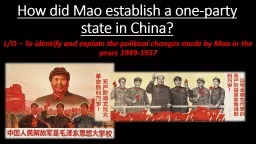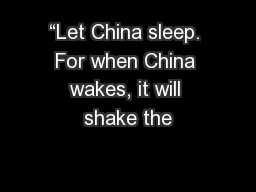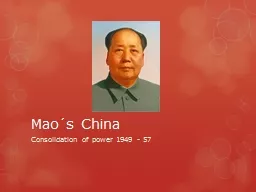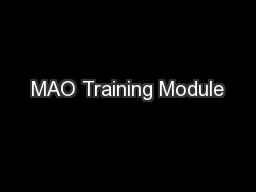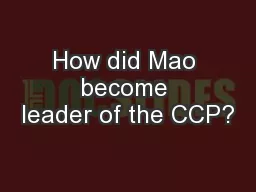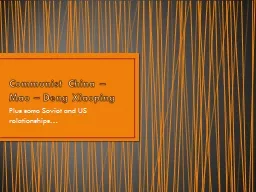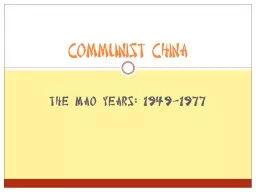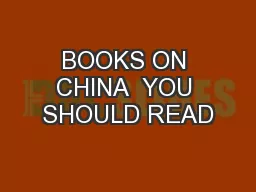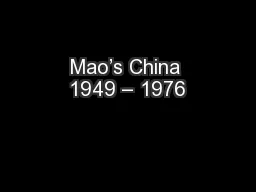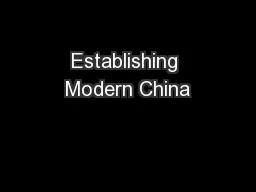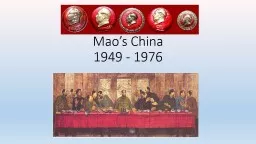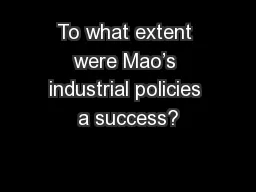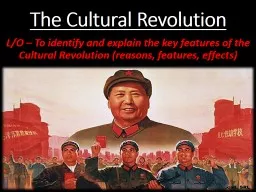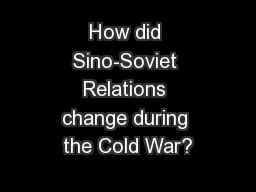PPT-How did Mao establish a one-party state in China?
Author : calandra-battersby | Published Date : 2016-08-02
LO To identify and explain the political changes made by Mao in the years 19491957 The OneParty State From 1949 China became a one party state All other parties
Presentation Embed Code
Download Presentation
Download Presentation The PPT/PDF document "How did Mao establish a one-party state ..." is the property of its rightful owner. Permission is granted to download and print the materials on this website for personal, non-commercial use only, and to display it on your personal computer provided you do not modify the materials and that you retain all copyright notices contained in the materials. By downloading content from our website, you accept the terms of this agreement.
How did Mao establish a one-party state in China?: Transcript
LO To identify and explain the political changes made by Mao in the years 19491957 The OneParty State From 1949 China became a one party state All other parties were suppressed in a series of . 1. Elena Songster & Jessica Stowell, OU. The . Mao Cult. . Revering Mao in Tibet during the Cultural Revolution. Mao: Cult of Personality. Charismatic leadership. Mao becomes the preeminent leader. Confucianism - The philosophy has shaped the Chinese political system since the 6th century B.C.E. . It emphasized the importance of order and harmony, and encouraged Chinese citizens to submit to the emperor's power, and reinforced the emperors' responsibility to fulfill his duties conscientiously. . Consolidation of power 1949 - 57. Problems and challenges for Mao´s regime. Infrastructure; considerable damages after so many years of war.. Economy: corruption wide spread; inflation high; industry undeveloped; - major reconstruction needed.. MAO login into . mFMS. . MAO’s can login into . mFMS. web . application. . by clicking onto ‘Registration and Data Upload Services’ on www.mfms.nic.in and providing login credentials received on mobile.. L/O – To identify how Mao took control of the CCP. Tasks. Make a timeline of Mao’s rise to power from 1919-1937. Include a brief description of each event (50 words max).. What were the most important events in Mao’s rise to power? Why? (try to identify at least 3 events). Plus some Soviet and US relationships…. Two Chinas. 1949 . PRC Mainland. Republic of China (Taiwan). Taiwan holds legal status and UN recognition until 1979 (Carter). Communist China Goals. Single-party state led by Mao. Communist China. The . Good Years: 1949-1958. China Packet III, Assignment 1. Assignment 1. New Expectations. Once the Nationalists were defeated, . Chairman Mao Zedong . and China’s Communists brought changes to every village. When dedicated Communist Party members arrived in a village to enact changes, he or she (usually) had the support of grateful peasants. . David Hickey. April 2012. Social/Political Background; Contemporary Life (1994):. It's what you would call a journalistic "sweeping" book - each chapter takes on a different aspect - Communism, capitalism, the peasants, the intellectual life….. Introductory Lesson . What does China mean to you? . What does this man mean to you? (if anything?) . Do you know any of these places? . B. C. D. A. E. F. Who was responsible for the most deaths…? . What factors contributed to the downfall of the Qing Dynasty?. Overpopulation. Food shortages (famine). Wars. Qing Dynasty. WARS. Opium War. The Chinese government took all of the opium the British had stored in the Chinese port of Canton.. Presentation Outline. Theoretical Maoism. Overview of the Civil War in China. The Great Leap Forward. The 100 Flowers Campaign. The Cultural Revolution. Maoist Propaganda. Conclusions. Reconciliation with the West. L/O – To analyse the impact of Mao’s . industrial policies . and evaluate their successes and failures. The CCP and Industry. As a Marxist organisation, the CCP was committed to ‘. building socialism. Mao Resigns. Mao . resigned. as President of China in . 1959. . He remained as . Chairman. of the CCP. China was now controlled by three leading Communists:. President, . Liu . Shaoqi. Prime Minister, . L/O - To identify and explain the reasons for the key turning points in Sino-Soviet Relations. Sino-Soviet Relations in the Cold War. As two Communist nations, you would have expected the USSR and PRC to be allies during the Cold War against American ‘.
Download Document
Here is the link to download the presentation.
"How did Mao establish a one-party state in China?"The content belongs to its owner. You may download and print it for personal use, without modification, and keep all copyright notices. By downloading, you agree to these terms.
Related Documents

